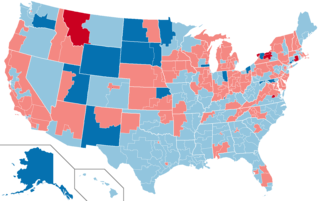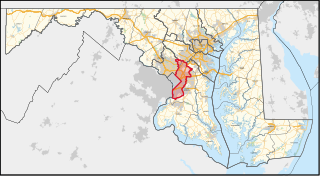
Since Arizona became a U.S. state in 1912, it has sent congressional delegations to the United States Senate and United States House of Representatives, beginning with the 63rd United States Congress in 1913. Before becoming a state, the Arizona Territory elected a non-voting delegate at-large to Congress from 1864 to 1912. Each state elects two senators to serve for six years, and varying numbers of members of the House, depending on state population, to two-year terms. Arizona has sent nine members to the House in each delegation since the 2010 United States Census.

The 1976 United States Senate elections was an election for the United States Senate. Held on November 2, the 33 seats of Class 1 were contested in regular elections. They coincided with Democrat Jimmy Carter's presidential election and the United States Bicentennial celebration. Although almost half of the seats decided in this election changed parties, Carter's narrow victory did not provide coattails for the Democratic Party. Each party flipped seven Senate seats, although, one of the seats flipped by Democrats was previously held by a Conservative.

The 2002 United States House of Representatives elections were held on November 5, 2002, in the middle of President George W. Bush's first term, to elect U.S. Representatives to serve in the 108th United States Congress. This was the first congressional election using districts drawn up during the 2000 United States redistricting cycle on the basis of the 2000 census.

The 1970 United States House of Representatives elections was an election for the United States House of Representatives held on November 3, 1970, to elect members to serve in the 92nd United States Congress. They occurred in the middle of Richard M. Nixon's first term as president. His party, the Republican Party, lost a net of 12 seats to the Democratic Party, which thereby increased its majority in the House. Many viewed the results of the 1970 election as an indication of public fatigue over the ongoing Vietnam War as well as the fallout from the Kent State Massacre.

The 1942 United States House of Representatives elections were elections for the United States House of Representatives to elect members to serve in the 78th United States Congress. They were held for the most part on November 3, 1942, while Maine held theirs on September 14. This was the first election after the congressional reapportionment based on the 1940 census, and was held in the middle of President Franklin D. Roosevelt's third term. With involvement in World War II, it was the first wartime election in the United States since 1918.

Since becoming a U.S. state in 1959, Alaska has been entitled to one member in the United States House of Representatives. The representative is elected at-large, because the state has only one congressional district, encompassing its entire territory. By area, Alaska's congressional district is the largest congressional district in the United States and the third-largest electoral district represented by a single member in the world. It is exceeded by Yakutsk district in Russia, which is similar in size to India and is the largest, and Nunavut, which comprises a single electoral district in Canada.

Maryland's 8th congressional district is concentrated almost entirely in Montgomery County, with a small portion in Prince George's County. Adjacent to Washington, D.C., the 8th district takes in many of the city’s wealthiest inner-ring suburbs, including Bethesda, Chevy Chase, and Potomac. It also includes several more economically and racially diverse communities, the most populous of which are Rockville and Silver Spring.
Arizona's 1st congressional district is a congressional district located in the U.S. state of Arizona, covering northeastern Maricopa County. Before 2023, geographically, it was the eleventh-largest congressional district in the country and included much of the state outside the Phoenix and Tucson metropolitan areas. From 2013 through 2022, it also included the Navajo Nation, the Hopi reservation, and the Gila River Indian Community, with 25% of the population being Native American. At that time, the district had more Native Americans than any other congressional district in the United States. In the 2022 elections, David Schweikert was elected in the redefined district. It was one of 18 districts that would have voted for Joe Biden in the 2020 presidential election had they existed in their current configuration while being won or held by a Republican in 2022.

Maryland's 4th congressional district wraps around the eastern edge of Washington, D.C., taking in most of Prince George's County and a small portion of Montgomery County. It is home to several racially diverse middle-class suburbs, including College Park, Fort Washington, Greenbelt, and Laurel. With a median household income of $86,941, it is the wealthiest black-majority district in the United States.

Virginia's 10th congressional district is a U.S. congressional district in the Commonwealth of Virginia. It is represented by Democrat Jennifer Wexton, who was first elected in 2018.

The 1970 United States House of Representatives elections in South Carolina were held on November 3, 1970, to select six Representatives for two-year terms from the state of South Carolina. The primary elections were held on June 9 and the runoff elections were held two weeks later on June 23. All five incumbents who ran were re-elected and the open seat in the 2nd district was retained by the Republicans. The composition of the state delegation remained five Democrats and one Republican.

The 2010 congressional elections in Arizona were held on November 2, 2010, to determine who would represent the state of Arizona in the United States House of Representatives. Arizona had eight seats in the House, apportioned according to the 2000 United States census. Representatives were elected for two-year terms; those elected were to serve in the 112th Congress from January 3, 2011, until January 3, 2013.

The 1994 United States Senate election in Arizona was held November 8, 1994. Incumbent Democratic U.S. Senator Dennis DeConcini decided to retire instead of seeking a fourth term. Republican nominee Jon Kyl won the open seat, becoming the first Republican to win Arizona's Class 1 Senate seat since Paul Fannin in 1970. Democrats would not win this seat again, or any Senate race in the state, until Kyrsten Sinema's victory in 2018.

The 2012 United States House of Representatives elections in Arizona were held on Tuesday, November 6, 2012, to elect the nine U.S. representatives from the state, one from each of the state's nine congressional districts, including the newly created 9th district following the 2010 United States census. The elections coincided with other federal and state elections, including a quadrennial presidential election, and a U.S. Senate election. Primary elections were held on August 28, 2012.

The 2000 congressional elections in Arizona were elections for Arizona's delegation to the United States House of Representatives, which occurred along with congressional elections nationwide on November 7, 2000. Arizona has six seats, as apportioned during the 1990 United States census. Republicans held five seats and Democrats held one seat.

The 2002 congressional elections in Arizona were elections for Arizona's delegation to the United States House of Representatives, which occurred along with congressional elections nationwide on November 5, 2002. Arizona has eight seats, as apportioned during the 2000 United States census and thus gaining two since the previous election. Democrats and Republicans each gained a seat as result, with Republicans having six seats and Democrats having two seats.

The 1970 United States Senate election in Indiana took place on November 3, 1970. Incumbent Democratic U.S. Senator Vance Hartke was narrowly re-elected to a third term in office over Republican U.S. Representative Richard Roudebush. This election was the only time since 1893 that an incumbent Democratic Senator from Indiana was re-elected or won re-election for this seat. As of 2024, this is the last time that an incumbent Democratic Senator from Indiana was re-elected or won re-election for this seat.

The 1972 United States Senate election in Colorado took place on November 7, 1972. Incumbent Republican U.S. Senator Gordon Allott ran for re-election to a fourth term, but was narrowly defeated by Democratic former State Representative Floyd Haskell. This would be the last time until 2008 that a Democrat was elected to the Class 2 Senate seat from Colorado. Colorado was one of fifteen states alongside Alabama, Arkansas, Delaware, Georgia, Iowa, Louisiana, Maine, Minnesota, Mississippi, Montana, New Hampshire, Rhode Island, South Dakota and West Virginia that were won by Republican president Richard Nixon in 1972 that elected Democrats to the United States Senate.

The 2020 United States House of Representatives elections in Arizona were held on November 3, 2020, to elect the nine U.S. representatives from the state of Arizona, one from each of the state's nine congressional districts. The elections coincided with the 2020 U.S. presidential election, as well as other elections to the House of Representatives, elections to the United States Senate and various state and local elections. This election was the first time since 1990 in which no third-party candidates appeared on the ballot in the House of Representatives elections.

Juan Ciscomani is an American politician serving as the U.S. representative for Arizona's 6th congressional district since 2023.




















